Tesla Model 3 Long Range (2021) review: the Model 3 is better than ever
The Model 3 remains the yardstick for EVs
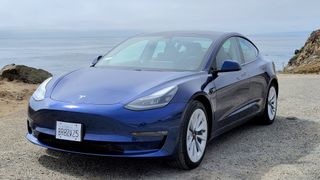
Two-minute review
The Tesla Model 3 has been the best-selling EV since its debut in 2017 - alongside its newer CUV sibling, the Model Y. But unlike other car manufacturers, Tesla doesn't update its vehicles yearly. Instead, it updates the hardware as needed, and the software monthly over-the-air (OTA) -- often adding new features for free.
As such, a 2017 Model 3 might appear similar to one purchased today, but there are important differences under the skin. We've already clocked significant seat time in a 2018 Model 3 Long Range (RWD) with Enhanced Autopilot, and we've just spent three weeks with a brand new mid-2021 Model 3 Long Range (AWD) with Acceleration Boost.
The Model 3 Long Range embodies everything that makes Tesla cars such class leading EVs: extensive range (353 miles), access to Tesla's vast Supercharger network, amazing performance (0-60mph in 4.2s), and Autopilot driver assistance - all packaged in a small, minimalist, nimble, and comfortable vehicle that costs $49,990 / £48,490 before incentives.
- Porsche Taycan 4S review: if your pockets are deep enough, it's a superb EV
- Polestar 1 review: Swedish smarts with American muscle looks
- Polestar 2 review: the firm's first fully-electric car
Design-wise, the exterior is stylish, with an emphasis on aerodynamics. While it lacks the elegance of the larger Model S sedan, we like the Model 3's proportions. And, despite being smaller, there's still ample storage (including a frunk).
The interior is ultra-minimalist, with open-pore wood spanning the width of the dashboard - now extending into new, updated door cards. The center console has also been revised, dropping the piano-black finish for a less fingerprint-prone material, improving the wireless phone charging pad, and switching wired connectivity to USB Type-C.

Black vegan leather is the default seating material, with white vegan leather costing $1,000 / £1,100 more. The front seats are supremely comfortable, and the Model 3's interior is an extremely pleasant place to be. Materials are decent, and build quality is noticeably better than the 2018 Model 3 we've previously driven.
With almost no buttons or switches beyond window and seat controls - and no instrument cluster in front of the driver - the Model 3 relies almost completely on its large and bright 15-inch center touchscreen for most functions.
Get daily insight, inspiration and deals in your inbox
Get the hottest deals available in your inbox plus news, reviews, opinion, analysis and more from the TechRadar team.
And four years in, this display is still the most intuitive and responsive in the business. It’s basically a giant iPad.
That large and responsive screen is also home to Model 3's state-of-the-art LTE-connected infotainment system, which includes navigation, real-time traffic, route planning, and charging network integration, plus apps like Spotify, Netflix (to watch shows while charging), a web browser, a bunch of games, and more. Again, think iPad.
Autopilot/FSD (full self driving) is arguably the most developed Level 2 ADAS (advanced driver assistance system) on the market today. Autopilot is standard, but FSD is a $10,000 / £6,800 one-time upgrade or $200 per month subscription, which you can purchase anytime via the Tesla app. That includes FSD (beta), Navigate on Autopilot, Autopark, and Summon.
This mid-2021 Model 3 lacks FSD, but Autopilot (adaptive cruise control with auto steering) is really impressive.
It's especially helpful in stop-and-go traffic and for long freeway drives, as it reduces the driver's workload, minimizing fatigue.
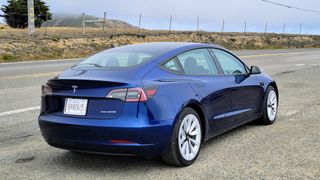
Despite all the tech, the Model 3 is a proper driver's car. Performance is outstanding, with a 0-60mph time ranging from 5.3 to 3.1 seconds.
This mid-2021 Model 3 Long Range includes Acceleration Boost, a $2,000 / £1,500 upgrade (basically a software update) which you can purchase via the Tesla app. It improves the 0-60mph time from 4.2 to 3.7 seconds.
The Model 3's ride is firm but compliant, and handling is excellent thanks to the low center of gravity (battery pack under the floor), 48/52 weight distribution, and quick steering. If anything, the all-season tires are the limiting factor here, with this mid-2021 Model 3 Long Range riding on the optional $1,500 / £1,500 19-inch sport wheels and tires (vs the default 18-inch setup).
On paper, this Model 3 Long Range boasts an EPA range of 353 miles. Realistically, limiting the state-of-charge to 90% and dipping into the car's performance usually reduces the range to about 275 miles. When it's time for a refill, it takes less than 40 minutes to charge from 10 to 90% at 250kW using one of Tesla's 26,000+ Superchargers.
Four years after its debut, the Model 3 is better than ever. It remains the yardstick by which other entry-level luxury EVs are measured, a vehicle that no other car manufacturer has quite managed to beat - thanks to a unique combination of superior range, broad charging infrastructure, outstanding performance, and advanced technology.
Still, there's room for improvement, especially in terms of fit and finish. The sparse interior isn't for everyone, and some features which are expected at this price are strangely absent.
But ultimately, it's impossible not to recommend the Model 3. It represents an EV future that's attainable today, without having to make any major compromises.
Tesla Model 3 price and availability
- $49,990 before incentives
- Optional $10,000 "full self driving"
- Optional $2,000 Acceleration Boost
At the time of writing, Tesla Model 3 Long Range prices start at $49,990 / £48,490 / AU$73,400 before incentives. Standard features include Autopilot, 18-inch Aero wheels, black interior, and white paint.
Options include Full Self Driving ($10,000/ £6,800), Acceleration Boost ($2,000/ £1,500), 19-inch sport wheels ($1,500/ £1,500), black and white interior ($1,000 / £1,100), black / silver / blue paint ($1,000/ £1,100), and red paint ($2,000/ £2,100).
The mid-2021 Tesla Model 3 Long Range we tested cost $54,490 and came with the Acceleration Boost, 19-inch sport wheels, standard black interior, and blue paint.
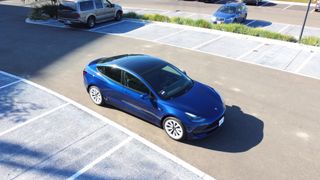
Tesla Model 3 design
- Minimalist and spacious interior
- Supremely comfortable seats
- Fit and finish issues
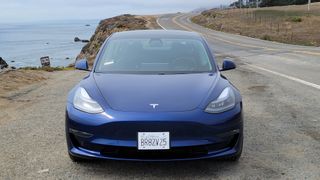
Tesla Model 3 long-range
Battery: 82kWh
Top Speed: 145mph
0-62mph: 3.7 seconds
Range: up to 353 miles EPA
Price: $54,490
From the outside, the Model 3 is stylish but also somewhat generic. It combines proportions of a relatively small, premium RWD sedan with design elements often found on more pedestrian Japanese and Korean cars. This isn't too surprising when you consider that Tesla's chief designer -- Franz von Holzhausen -- previously worked at Mazda.
We think this design works, especially the frameless windows, flush door handles, and straight cut rear door edges. Still, the Model 3 lacks the elegance and presence of Tesla's larger Model S sedan.
The most controversial part is definitely the nose, which is missing a traditional grille, and only features openings below the bumper -- much like on a Porsche.
Inside, the Model 3's design is pleasantly minimalist and very Scandinavian. Open-pore wood spans the width of the dashboard, along with a single narrow vent.
The low cowl helps with forward visibility, but there's no instrument cluster on the dash -- or even controls for that matter. Almost everything happens on the large and bright 15-inch center touchscreen.
Even the headlights, windshield wipers, and vents are controlled using the display. You'll find window switches in the door panels - which now feature the same open-pore wood motif as the dash - seat controls on the side of the seats, and a hazard button plus map lights above the rearview mirror. There isn't even a button for the glovebox.
The lack of instrument cluster and dedicated buttons and switches is honestly much less of a deal than most people make of it. While we'd have liked a few more traditional controls, we quickly became accustomed to using that big, responsive center touchscreen - not to mention the convenient scroll wheels on the steering wheel, which control the basics.
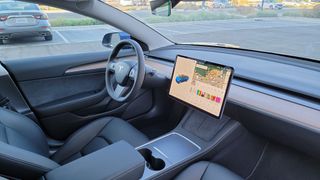
By default, those scroll wheels handle media controls (left) plus Autopilot settings and voice input (right). The left one also adjusts the side mirror and steering wheel position when enabled from the display.
As for the stalks, the left one controls the indicators, high beams, and windshield spray, while the right one handles gear selection and Autopilot activation.
After driving any Tesla, standard car interiors just feel downright cluttered and old fashioned. There's also no traditional key fob (it's optional) or start button.
Your phone is your key, and the Model 3 comes with a couple NFC key cards as a backup. As for starting the car, just sit down, press the brake pedal, and shift into drive. It makes perfect sense.
Vegan leather is Tesla's fabric of choice. It covers the seats and steering wheel - which are all heated, including all three rear seats.
Rear passengers have to ask the driver or front passenger to activate the seat heaters since there are no switches for them in the back. The front seats are incredibly comfortable, especially on long drives. Seating position is superb, too.
Unfortunately, as of mid-2021, the Model 3 (and Model Y) no longer offers adjustable lumbar support for the front passenger seat, something that used to be standard on both vehicles.
This appears to be the result of supply-chain issues since other manufacturers (like BMW) have also dropped this feature - at least for the time being. Still, it's a bummer.








Despite its midsize (EPA) / compact executive (D segment) classification, the Model 3's interior is spacious. This is further amplified by the low cowl and large (fixed) glass roof.
Since it's an EV, the cabin isn't constrained by mechanical components. Head and legroom are plentiful in front, but even the rear passengers benefit from ample space.
The recently updated center console features two Qi-compatible wireless charging pads covered in Alcantara, one deep storage cubby (with two USB Type-C ports) under a sliding door, two cup holders, another deep storage cubby (with a standard 12V outlet) under the center armrest, plus vents and another pair of USB Type-C ports facing the rear.
You'll also find a storage pocket in each door, including a small bottle holder in each front door, plus a pair of cupholders in the rear seat's folding center armrest.
The glove box is small, but features a USB Type-A port for a USB thumb drive (128GB, provided) that's used by the infotainment system to store Dashcam and Sentry Mode recordings.
The trunk is quite large and includes additional space under half the floor (enough for a small roller bag) plus a deep storage cubby behind the left wheel well.
As a bonus, the rear seats fold down 40/60, and the Model 3 now features a power trunk lid (new for 2020). The frunk is also big enough for a small roller bag. In all, there's 15 cubic feet (425 liters) of storage.
Materials are fine overall, and build quality is significantly better than it was after the Model 3's debut in 2017.
While everything is solid, there's room for improvement. Fit and finish, in particular, still doesn't quite match entry-level luxury standards. The interior just lacks the kind of refinement you'd experience in an Audi, for example.









Tesla Model 3 drive, range and charging
- Amazing performance
- Superior range
- Vast charging network
If you like driving, you'll love the Model 3. This car delivers serious performance, with 0-60mph times ranging from 5.3 to 3.1 seconds (0-100km/h in 5.6 to 3.3s), and top speeds ranging from 140 to 162mph (225 to 261km/h).
According to Tesla, the Model 3 Long Range reaches 0-60mph in 4.2 seconds, with a top speed of 145mph - that's pretty fast.
The mid-2021 Tesla Model 3 Long Range we tested came with Acceleration Boost, a $2,000 upgrade that can be purchased in the Tesla app.
It's basically a software update that lowers the 0-60mph time to 3.7 seconds. That's only 0.6s slower to 60mph than the Model 3 Performance, which costs $7,000 more. Acceleration is even adjustable (chill and sport).
But the Model 3 isn't just about 0-60mph times. It's a joy to drive. Handling is sharp thanks to the battery pack located under the floor (low center of gravity), 48/52 weight distribution, and quick steering.
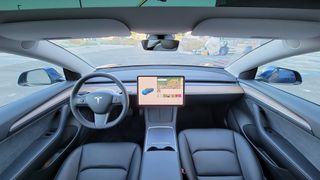
The ride is firm but compliant - Tesla's clearly done a great job tuning the suspension to maximize performance without sacrificing comfort.
The mid-2021 Model 3 Long Range we reviewed was equipped with the optional $1,500 19-inch sport wheels and tires.
While better than the default 18-inch setup, both all-season tires options prioritize comfort over performance, leaving room for improvement. This won't matter to most people, but keep this in mind if you're an enthusiast.
Steering is precise and responsive, with decent feedback (at least for a modern car), and the steering weight is adjustable (comfort, standard, and sport).
The brakes are strong and easy to modulate, but brake feel is nothing special. Fortunately, Tesla isn't blending regen with hydraulic braking here. Regen only happens when lifting off the throttle.
This brings up another interesting Model 3 feature. While there are no drive modes, the stopping mode - how the car behaves when the pedals are released - is adjustable (creep, roll, and hold).
'Creep' behaves like an automatic transmission, 'roll' mimics a manual transmission with the clutch disengaged, and 'hold' just keeps the vehicle stationary.
Regen strength isn't adjustable on the current Model 3 and is pretty strong (presumably to maximize range).
Lifting off the throttle is similar to engine braking in second gear with a manual transmission vehicle. This, combined with the 'roll' setting, makes for a very natural driving experience for stick-shift enthusiasts. We're big fans.
Setting the stopping mode to 'hold' basically enables one-pedal driving. But regardless of which stopping mode you prefer, pressing the brake pedal briefly when stopped temporarily holds the Model 3 stationary until either pedal is pressed again, so you don't have to keep your foot on the brake when stopped if you don't want to (like on a hill, for example).
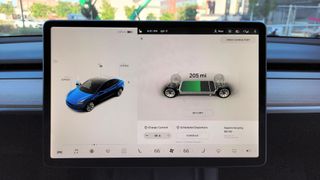
The Model 3 Long Range is equipped with an 82kWh battery pack, for an EPA range of 353 miles / 568 kilometers (360mi / 580km WLTP).
Since the entire capacity of the battery pack is available to the driver, it's probably wise to maximize battery pack health and limit the state-of-charge to 90% for a range of 318mi / 512km.
We drove the Model 3 Long Range for about 600 miles in and around San Francisco on a variety of roads (city and suburban streets, country roads, highways and freeways) over a three week period, and Supercharged three times (from about 25% to about 90%). There are a lot of hills in the Bay Area, and the weather is sunny but mild.
In all, using only 90% of the battery pack's capacity, we found the effective range with one passenger, air conditioning, and the occasional bout of spirited driving to be about 275 miles / 443 kilometers.
That's pretty impressive, and handily beats most of the competition - especially when you consider how much performance there's on tap.
The Model 3 is available in three versions - Standard Range Plus (RWD, 0-60mph in 5.3s, $39,990) with 263mi / 448km of range, Long Range (AWD, 0-60mph in 4.2sec, $49,990) with 353mi / 580km of range, and Performance (AWD, 0-60mph in 3.1s, larger 20-inch wheels, bigger brakes, lowered suspension, $56,990), with 315mi / 567km range.


When it comes to charging, the Model 3 Long Range uses a proprietary connector in the US and a CCS Combo 2 connector in most other markets.
It supports up to 250kW DC fast charging and up to 11.5kW AC charging (Level 1 and 2). A J1772 adapter is provided with the Model 3 in the US to allow AC charging at non-Tesla stations.
As you'd expect, the Model 3 also comes with Tesla's Mobile Connector. It consists of a small waterproof box attached to a 20ft (6m) charging cable and enables AC charging on most household outlets.
A range of optional adapters is available from Tesla to use the Mobile Connector with other, more powerful outlets (up to 7.6kW).
DC fast charging from 10 to 90% takes about 40 minutes using a 250kW Supercharger (peaking at 1000mph) and about 55 minutes using a 150kW Supercharger.
However, charging from 10 to 50% only takes about 15 minutes at 250kW. AC charging from 10 to 90% takes about 12 hours at 7.6kW (Level 2) and about 56 hours at 1.9kW (Level 1).
What really differentiates the Model 3 Long Range from the competition - beyond the excellent range and amazing performance - is Tesla's worldwide network of 26,000+ Superchargers, which is currently exclusive to Tesla vehicles.
In the US, Superchargers are spaced about 150 miles apart on most freeways and major highways, enabling long-distance travel.
Tesla operates a referral program which lets existing Tesla owners give 1000 miles (1600km) of free Supercharging to new Tesla owners and enjoy 1000 miles of free Supercharging themselves in return.
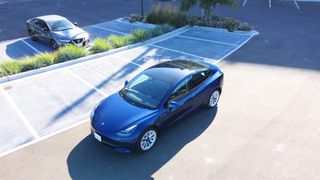
Tesla Model 3 specs and tech
- Monthly software updates
- Intuitive and responsive infotainment
- Sophisticated driver assistance
Four years in, and the Tesla Model 3 is still packed with some of the most advanced technology available in any vehicle today.
Instead of traditional model-year updates and mid-cycle refreshes, Tesla improves its hardware when necessary (multiple times a year), and its software - with free new features - at regular intervals (almost monthly) via OTA (over-the-air) updates.
Over the years, some of these hardware changes have included upgrading the Autopilot/FSD (full self driving) computer, replacing the resistive heater with a more efficient heat pump, mildly refreshing the interior and exterior, increasing the battery capacity, and - most recently - removing the radar sensor and switching a vision-centric system called Tesla Vision.
While a 2017 Model 3 might look similar to a brand new one, these are different cars under the skin. The software changes have been numerous as well, making that older Model 3 a significantly better vehicle than it was four years ago.
For example, Tesla uses machine learning to improve Autopilot/FSD, with each car feeding more data into the system.
Obviously, connectivity is key for all this to work, and the Model 3 includes always-on basic LTE connectivity for free.
Premium LTE connectivity (which is free for the first year of ownership) costs $10 per month, and gives the infotainment system unlimited Internet access on the go. The Model 3 also supports Wi-Fi connectivity when parked at home.
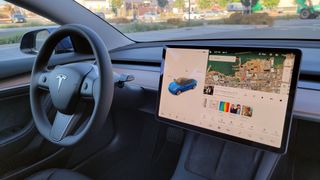
With no instrument cluster - and almost no buttons or switches beyond window and seat controls - everything (instruments, controls, climate, navigation, entertainment) revolves around the Model 3's single 15-inch center touchscreen.
As such, it's best to think of this display as a giant iPad - complete with apps. In fact, it's just as intuitive and responsive to use.
That high-quality screen really sets the Model 3's infotainment system apart from the competition. In addition to the usual functionality - like navigation, real-time traffic, route planning, and charging network integration - it includes apps for Spotify, TuneIn radio, Netflix, Hulu, YouTube, Twitch, and Disney+ (currently rolling out).
Beyond these media-centric apps, there's also a web browser, calendar, karaoke app, and music creation app (Trax), plus a bunch of fun video games like Polytopia, Solitaire, Asteroids, and more.
The infotainment system even supports game controllers (via USB) - with some games using the Model 3's steering wheel and pedals as a controller.
One app (called Boombox) lets you change the sound of the horn, and the sound the Model 3 makes when driving at low speeds (using preset sounds or even your own sounds).
All this might seem frivolous, but the idea is to make charging more fun. We found ourselves binge watching Star Trek: Voyager on Netflix while filling up at Superchargers.



Additional connectivity includes Bluetooth and USB (mass-storage) audio support, plus contact, call log, text message, and calendar sync via Bluetooth.
The Model 3's audio system sounds fantastic, but fans of radio will be disappointed. While it features an FM radio (and DAB in some markets), it lacks AM or Sirius-XM (satellite) support.
The Model 3 also supports voice commands like "navigate to San Francisco", "display Superchargers", "turn on windshield wipers", "set the temperature to 68 degrees", "search Google for the weather", "call John Smith", "play Bohemian Rhapsody", etc… It works pretty well, and even lets you respond to text messages.
In terms of driver assistance, the Model 3 checks all the boxes. It offers ultrasonic parking sensors, adaptive cruise control, plus automatic lights, high-beams, and wipers.
Safety features are comprehensive, and include blind spot warning, lane departure warning, lane keeping assist, forward collision warning, and automatic emergency braking.
You'll also find a total of eight cameras around the car - three behind the windshield in front, one in the rear (backup camera), one on each fender, and one on each B-pillar.
Tesla Vision uses these cameras (along with the ultrasonic parking sensors) to provide these driver assistance and safety features, plus Autopilot/FSD functionality.
When it comes to ADAS, Autopilot/FSD is arguably the most advanced Level 2 system currently available.
Autopilot is standard on the Model 3, but FSD is a $10,000 one-time upgrade or $200 per month subscription. This includes FSD (beta), Navigate on Autopilot, Autopark, and Summon, and can be purchased anytime in the Tesla app.
Autopilot basically combines automatic steering (which goes far beyond lane keeping assist) and adaptive cruise control, providing Level 2 ADAS on highways and freeways.
FSD (beta) is basically Autopilot for city streets, and is capable of handling other vehicles, pedestrians, intersections, roundabouts, traffic lights, stop signs, etc. While usable in the States, FSD isn't fully enabled in most markets due to local legislation - but when/if that changes, the Model 3 has the technology to offer it right away.
Navigate on Autopilot adds automatic lane change (initiated using the left stalk) plus automatic highway interchange and on/off ramp navigation to standard Autopilot.
Autopark enables self parking, and Summon lets you control your Model 3 from the Tesla app without being inside the vehicle, which helps when parking in tight spaces, for example.
The cameras are also used for two other features. Dashcam (as its name implies) captures video from the main front camera, the two fender-mounted cameras, and the rear camera as long as the Model 3 is unlocked.
Sentry Mode records video from the same four cameras when the vehicle is locked, and motion or shock is detected -- for additional security.
Dashcam and Sentry Mode videos are stored on a USB thumb drive (128GB, provided) that's plugged into a USB Type-A port inside the glovebox.
There are also two USB Type-C ports (power and data) inside the center console - which are hard to reach - plus two more USB Type-C ports (power only) in the back of the center console for the rear passengers.
Finally, the Tesla app (for iOS and Android) is extremely useful. It turns your phone into a key for the Model 3, complementing the two NFC key cards that come with the car.
You can also share an address or location from any app on your phone (maps, contacts) with the Tesla app, which then sends it to the Model 3's navigation system - it's super handy.
Obviously, the Tesla app also lets you open the trunk or frunk, open or close the windows, adjust the climate, access various controls (like Sentry Mode), monitor charging, find nearby Superchargers, locate your car, purchase upgrades like FSD or Acceleration Boost, manage service appointments, and contact roadside assistance.
We'd have loved to see a HUD (heads-up display) on the driver side, or a 360-degree view when parking - especially considering the Model 3's many cameras.
Apple CarPlay and Android Auto are also missing here, which is surprising, but isn't really much of an issue considering how capable the infotainment system is.
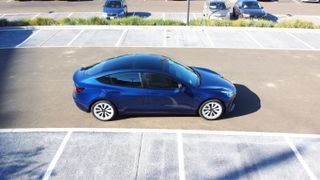
Should I buy a Tesla Model 3?
Buy it if...
You want superior range
With an EPA range of 353 miles, the Tesla Model 3 Long Range beats most of the competition. It's also the most efficient EV on the market today.
You want a vast charging network
Tesla's worldwide network of 26,000+ Superchargers enables worry-free long-distance travel. With charging speeds up to 250kW, it's very fast, too.
You want outstanding performance
With a 0-60mph time of 4.2 seconds, the Model 3 Long Range is seriously quick. It's also a joy to drive on back roads, thanks to nimble handling.
Don't buy it if...
You want buttons and switches
Other than window and seat controls, everything happens on the Model 3's single 15-inch center touchscreen. We don't mind, but it's not for everyone.
You want a more refined interior
The Model 3 is a small, premium sedan with a stylish exterior. But the interior lacks the kind of refinement you'd expect in this category.
You want better fit and finish
Build quality has improved significantly since the Model 3's 2017 debut. Unfortunately, fit and finish still doesn't quite match entry-level luxury standards.
First reviewed: August 2021

Myriam Joire (tnkgrl) was born wearing combat boots and holding a keyboard. Moments later she picked up a soldering iron. On weekends, she rally-raced with her father. She's been stomping, typing, hacking, and driving ever since. After spending years being a code-monkey in the video game industry, she joined Engadget as Senior Mobile Editor and later Pebble as Chief Evangelist. Today she hosts the weekly Mobile Tech Podcast, makes videos on YouTube, writes about tech and cars for TechRadar and other major publications, and advises startups on product/media strategy. She's based in San Francisco.
Most Popular


